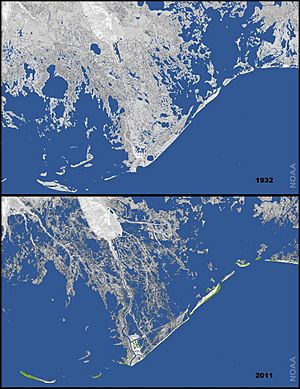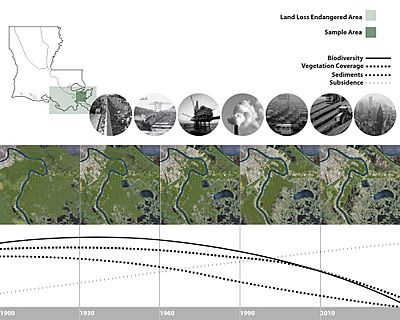Coastal erosion in Louisiana facts for kids
Coastal erosion in Louisiana means the steady loss of land along the state's coast. This includes important areas like wetlands, marshes, swamps, and barrier islands. It especially affects the land around the mouth of the Mississippi River near the Gulf of Mexico.
Over the last 100 years, Louisiana has lost a lot of its wetlands. Experts believe more land will be lost in the future. Some estimates say Louisiana loses wetlands equal to a football field every hour! When land disappears, it makes the area more open to damage from storm surges during hurricanes. This affects cities like New Orleans and other communities nearby.
Louisiana has a big plan to restore its coast. They have started projects like sending fresh water from the river into the marshes. But not all lost wetlands can be saved. So, some areas will be chosen as top priorities for restoration.
Coastal erosion happens for several reasons. One big reason is sea level rise. Another is that the Mississippi River no longer deposits as much sediment (dirt and sand) into its delta. This leads to marshes and wetlands being permanently flooded.
Human actions also play a part. For example, levees built along the river stop fresh water and silt from reaching the delta. This dirt used to naturally build up the land during spring floods. Now, the levees protect people and property but also stop the river from replenishing the land. Without new dirt, the plants that grow in fresh and brackish (slightly salty) water start to die. These plants are important because they help hold the soil together. As these plants disappear, saltier water from the Gulf of Mexico moves further inland. This kills even more non-saltwater plants, causing more land to wash away.
Other things that make erosion worse include canals and shipping routes. These were often dug for the petrochemical industry and for logging. These canals let saltwater from the Gulf move into areas that used to have fresh or brackish water. This harms the plants there. Also, the land itself is slowly sinking, a process called subsidence. While some of this is natural, removing oil and gas from underground can also make the land sink faster. Global warming is causing sea levels to rise, which also adds to the problem.
Contents
Why is Louisiana losing land?
Many things cause Louisiana to lose its valuable wetlands. Both natural processes and human activities are involved.
Human-made changes
People have built many levees along the Mississippi River. These levees are like walls that stop the river from flooding. While they protect homes and farms, they also stop the river's spring floodwaters. These floods used to bring fresh water and new dirt (sediment) to the marshes. Without this new sediment, the land slowly sinks and is replaced by saltwater from the Gulf. Since 1930, Louisiana has lost over 1,900 square miles (4,900 km²) of land. This is like losing 25 square miles (65 km²) of wetlands every year. It's similar to a football field disappearing every 30 minutes!
Canals dug for the oil and gas industry also cause problems. These canals allow saltwater to move deep into the marshes and swamps. This saltwater harms plants that need fresh or brackish water. Logging, especially of cypress trees in the early 1900s, also created canals. Once logging stopped, these canals continued to let saltwater in, stopping new cypress trees from growing.
The Mississippi River–Gulf Outlet Canal (MRGO) is another example. This canal, now closed, brought saltwater into freshwater marshes in St. Bernard Parish. This caused a lot of land to erode.
Sinking land and rising seas
The land in river deltas naturally sinks over time. This is called subsidence. Before levees were built, floods would bring new sediment to balance this sinking. But now, the sediment flows straight into the Gulf of Mexico. This means the land sinks faster than it can rebuild.
Some people think that taking out billions of barrels of oil and gas from underground also makes the land sink. They believe that when these materials are removed, the ground above them loses support and slowly collapses. Others argue that sinking is mostly natural for deltas. They say the main problem is the lack of new sediment from the river.
Rising sea levels due to global warming also make the problem worse. This means the ocean is slowly creeping higher onto the land.
Invasive species
An animal called the nutria was brought to Louisiana from South America in the 1930s. A few escaped, and now there are millions! Nutria eat marsh plants, which are important for holding the soil together. They also remove dead plant matter that would normally build up the marsh. Large alligators are natural predators of nutria. Using alligators might help control the nutria population and protect the wetlands.
What happens when wetlands disappear?
Louisiana's wetlands are very important. They offer many benefits that were not fully understood a long time ago.
Impact on nature
Wetlands are like natural sponges. They help control floods by soaking up water. They also filter water, removing pollution like heavy metals and pesticides before it reaches the Gulf. Wetlands are home to many different plants and animals. Trees like the bald cypress and tupelo gum grow there. You can also find plants like the dwarf palmetto and wax myrtle. Many animals live in the wetlands, including osprey, herons, egrets, alligators, and beavers. Wetlands are also important resting places for birds that migrate long distances.
Impact on people and economy
The disappearing wetlands have a big effect on Louisiana's culture and economy. The commercial fishing industry in Louisiana is worth over $300 million each year. More than 70% of this comes from seafood like shrimp, oysters, and blue crabs. These animals depend on the coastal wetlands as a nursery for their young.
Many people also enjoy hunting and fishing in the wetlands. Louisiana sells hundreds of thousands of hunting and fishing licenses each year. Other fun activities like boating, swimming, camping, hiking, and birdwatching are also popular in wetland areas. As the wetlands disappear, fewer people can enjoy these activities. Also, people who live in wetland areas are sometimes forced to move away.
How can we save Louisiana's coast?
Many projects and ideas are being tried to save Louisiana's coastal areas. The goal is to reduce human damage and restore the natural processes.
Restoration projects
One main method is called "freshwater diversions." This involves taking water from the Mississippi River at certain spots. This fresh water, along with its dirt and silt, is then sent into nearby marshes and estuaries. This helps freshwater plants grow and adds new sediment to build up the land. However, some people, like oyster farmers, don't like this. They need salty water for their oysters to grow well.
Another way to restore the coast is by directly planting new marsh grasses and other plants. Sometimes, large amounts of seeds are dropped from crop-dusters to help new plants grow. Mangrove seeds have also been tried. When mangroves grow, they help reduce the saltiness of the marsh water.
Moving already-dredged material (dirt and sand dug from the river) to marshes, swamps, and barrier islands is another option. Some people have even suggested removing levees in areas where not many people live. This would allow the river to naturally spread fresh water and silt into the marshes again. But this idea is still being debated.
Funding and plans
The Louisiana State Coastal Restoration Authority has a big plan for future coastal restoration and flood protection. By law, all money from oil and gas royalties collected by the state is supposed to go towards coastal restoration. However, Louisiana only gets a small part of these royalties right now. The rest goes to the federal government. Starting in 2018, Louisiana will get a larger share (37.5%) from new oil and gas leases. Money from the BP oil spill lawsuits and federal fines will also help fund coastal restoration.



